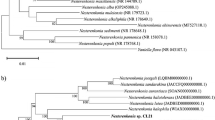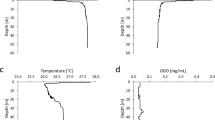Abstract
A ginsenoside Rg2-producing, Gram stain-negative, aerobic, catalase and oxidase-positive, rod-shaped, non-motile and orange pigmented novel bacterium designated strain MAH-28 T was isolated from soil sample of a grape garden. Strain MAH-28 T hydrolyzed aesculin, casein and DNA. Flexirubin-type pigments are present. Phylogenetic analysis based on 16S rRNA gene sequence showed that strain MAH-28 T formed a cluster within the genus Chitinophaga and the most close relatives were Chitinophaga alhagiae T22T (98.9% 16S rRNA gene sequence similarity), Chitinophaga humicola Ktm-2 T (98.8%), Chitinophaga barathri YLT18T (98.3%) and Chitinophaga lutea ZY74T (97.4%). The novel strain MAH-28 T has a draft genome size of 6,043,180 bp (14 contigs), annotated with 4,863 protein-coding genes, 53 tRNA and 6 rRNA genes. The ANI and dDDH values between strain MAH-28 T and the closely related type strains were in the range of 76.0–83.4% and 20.3–26.7%, respectively. The novel strain MAH-28 T was able to synthesize ginsenoside Rg2 from major ginsenoside Re. The genome annotation revealed 152 carbohydrate genes which may involve with the synthesis of ginsenoside Rg2. The respiratory quinone of strain MAH-28 T was MK-7 and the dominant cellular fatty acids were C15:0 iso, C16:1 ω5c and C17:0 iso 3-OH. The DNA G + C content of strain MAH-28 T was 53.3 mol%. Based on the phenotypic, chemotaxonomic and phylogenetic studies, strain MAH-28 T represents a new member of genus Chitinophaga for which the name Chitinophaga chungangae sp. nov. is proposed with type strain MAH-28 T (= KACC 19968 T = CGMCC 1.16605 T).


Similar content being viewed by others
References
Akter S, Huq MA (2018) Biological synthesis of ginsenoside Rd using Paenibacillus horti sp. nov. isolated from vegetable garden. Curr Microbiol 75:1566–1573
Akter S, Huq MA (2020) Biologically rapid synthesis of silver nanoparticles by Sphingobium sp. MAH-11 T and their antibacterial activity and mechanisms investigation against drug-resistant pathogenic microbes. Artif Cells Nanomed Biotechnol 48:672–682
Akter S, Lee SY, Siddiqi MZ, Balusamy SR, Ashrafudoulla M, Rupa EJ, Huq MA (2020) Ecofriendly synthesis of silver nanoparticles by Terrabacter humi sp. nov., and their antibacterial application against antibiotic-resistant pathogens. Int J Mol Sci 21:9746
Brettin T, Davis JJ, Disz T, Edwards RA, Gerdes S, Olsen GJ, Olson R, Overbeek R, Parrello B, Pusch GD (2015) RASTtk: A modular and extensible implementation of the RAST algorithm for building custom annotation pipelines and annotating batches of genomes. Sci Rep 5:8365
Chaudhary DK, Kim J (2018) Chitinophaga humicola sp. nov., isolated from oil-contaminated soil. Int J Syst Evol Microbiol 68:751–757
Chun J, Oren A, Ventosa A, Christensen H, Arahal DR (2018) Proposed minimal standards for the use of genome data for the taxonomy of prokaryotes. Int J Syst Evol Microbiol 68:461–466
Collins MD, Pirouz T, Goodfellow M, Minnikin DE (1977) Distribution of menaquinones in actinomycetes and corynebacteria. J Gen Microbiol 100:221–230
Doetsch RN (1981) Determinative methods of light microscopy. In: Gerhardt P (ed) Manual of methods for general bacteriology. American Society for Microbiology, Washington, DC, pp 21–33
Farh MA, Kim YJ, Van AH, Sukweenadhi J, Singh P, Huq MA, Yang DC (2015) Burkholderia ginsengiterrae sp. nov. and Burkholderia panaciterrae sp. nov., antagonistic bacteria against root rot pathogen Cylindrocarpon destructans, isolated from ginseng soil. Arch Microbiol 197:439–447
Felsenstein J (1981) Evolutionary trees from DNA sequences: a maximum likelihood approach. J Mol Evol 17:368–376
Felsenstein J (1985) Confidence limits on phylogenies: an approach using the bootstrap. Evolution 39:783–791
Frank JA, Reich CI, Sharma S, Weisbaum JS, Wilson BA, Olsen GJ (2008) Critical evaluation of two primers commonly used for amplification of bacterial 16S rRNA gene. Appl Environ Microbiol 74:2461–2470
Geraldi A (2020) Advances in the production of minor ginsenosides using microorganisms and their enzymes. BIO Integration 1:15–24
Guo L, Tuo L, Habden X, Zhang Y, Liu J (2015) Allosalinactinospora lopnorensis gen. nov., sp. nov., a new member of the family Nocardiopsaceae isolated from soil. Int J Syst Evol Microbiol 65:206–213
Hall TA (1999) BioEdit: a user-friendly biological sequence alignment editor and analysis program for Windows 95/98/NT. Nucleic Acids Symp Ser 41:95–98
Huq MA (2017) Chryseobacterium chungangensis sp. nov., a bacterium isolated from soil of sweet gourd garden. Arch Microbiol. https://doi.org/10.1007/s00203-017-1469-8
Huq MA (2018) Caenispirillum humi sp. nov., a bacterium isolated from the soil of Korean pine garden. Arch Microbiol 200:343–348
Huq MA, Siraj FM, Kim YJ, Yang DC (2016) Enzymatic transformation of ginseng leaf saponin by recombinant β-glucosidase (bgp1) and its efficacy in an adipocyte cell line. Biotechnol Appl Biochem 63:532–538
Kämpfer P, Lodders N, Falsen E (2011) Hydrotalea flava gen. n ov., sp. nov., a new member of the phylum Bacteroidetes and allocation of the genera Chitinophaga, Sediminibacterium, Lacibacter, Flavihumibacter, Flavisolibacter, Niabella, Niastella, Segetibacter, Parasegetibacter, Terrimonas, Ferruginibacter, Filimonas and Hydrotalea to the family Chitinophagaceae fam. nov. Int J Syst Evol Microbiol 61:518–523
Kimura M (1980) A simple method for estimating evolutionary rate of base substitutions through comparative studies of nucleotide sequences. J Mol Evol 16:111–120
Larkin MA, Blackshields G, Brown NP, Chenna R, McGettigan PA, McWilliam H, Valentin F, Wallace IM, Wilm A, Lopez R, Thompson JD, Gibson TJ, Higgins DG (2007) Clustal W and Clustal X version 2.0. Bioinformatics 23:2947–2948
Meier-Kolthoff JP, Auch AF, Klenk HP, Göker M (2013) Genome sequence-based species delimitation with confidence intervals and improved distance functions. BMC Bioinformatics 14:60
Overbeek R, Olson R, Pusch GD, Olsen GJ, Davis JJ, Disz T, Edwards RA, Gerdes S, Parrello B, Shukla M (2014) The SEED and the Rapid Annotation of microbial genomes using Subsystems Technology (RAST). Nucleic Acids Res 42:D206–D214
Reichenbach H (1992) The order Cytophagales. In: Balows A, Trüper HG, Dworkin M, Harder W, Schleifer KH (eds) The prokaryotes, vol 4, 2nd edn. Springer, New York, pp 3631–3675
Saitou N, Nei M (1987) The neighbour-joining method: a new method for reconstructing phylogenetic trees. Mol Biol Evol 4:406–425
Sangkhobol V, Skerman VBD (1981) Chitinophaga, a new genus of chitinolytic myxobacteria. Int J Syst Bacteriol 31:285–293
Sasser M (1990) Identification of bacteria by gas chromatography of cellular fatty acids. MIDI Inc, MIDI Technical Note 101. Newark, DE
Shi W, Sun Q, Fan G et al (2021) gcType: a high-quality type strain genome database for microbial phylogenetic and functional research. Nucleic Acids Res 49(D1):D694–D705
Siddiqi MZ, Siddiqi MH, Kim YJ, Jin Y, Huq MA, Yang DC (2015) Effect of fermented red ginseng extract enriched in ginsenoside Rg3 on the differentiation and mineralization of preosteoblastic MC3T3-E1 cells. J Med Food 18:542–548
Siraj FM, Natarajan S, Huq MA, Kim YJ, Yang DC (2015) Structural investigation of ginsenoside Rf with PPARγ major transcriptional factor of adipogenesis and its impact on adipocyte. J Gins Res 39:141–147
Tamura K, Stecher G, Peterson D, Filipski A, Kumar S (2013) MEGA6: Molecular evolutionary genetics analysis version 6.0. Mol Biol Evol 30:2725–2729
Wayne LG, Brenner DJ, Colwell RR, Grimont PAD, Kandler O, Krichevsky MI, Moore LH, Moore WEC, Murray RGE, Stackebrandt E, Starr MP, Trüper HG (1987) Report of the ad hoc committee on reconciliation of approaches to bacterial systematic. Int J Syst Bacteriol 37:463–464
Yoon SH, Ha SM, Kwon S, Lim J, Kim Y, Seo H, Chun J (2017a) Introducing EzBioCloud: a taxonomically united database of 16S rRNA and whole genome assemblies. Int J Syst Evol Microbiol 67:1613–1617
Yoon SH, Ha SM, Lim JM, Kwon SJ, Chun J (2017b) A large-scale evaluation of algorithms to calculate average nucleotide identity. Antonie Van Leeuwenhoek 110:1281–1286
Zhang L, Liao S, Tan Y, Wang G, Dan W, Zheng S (2015) Chitinophaga barathri sp. nov., isolated from mountain soil. Int J Syst Evol Microbiol 65:4233–4238
Zong Y, Wu M, Liu X, Jin Y, Wang G, Li M (2019) Chitinophaga lutea sp. nov., isolated from arsenic-contaminated soil. Int J Syst Evol Microbiol 69:2114–2119
Zou Y, Zhang X, Song H, Li Y, Cheng Q (2019) Chitinophaga alhagiae sp. Nov., isolated from rhizosphere soil of Alhagi sparsifolia. Int J Syst Evol Microbiol 69:1179–1184
Acknowledgements
I would like to give special thanks to CGM 10K project for analyzing the draft genome sequence of strain MAH-28T (GCM60012297).
Author information
Authors and Affiliations
Corresponding authors
Ethics declarations
Conflict of interest
The authors declare that they have no conflict of interest.
Additional information
Communicated by Erko Stackebrandt.
Publisher's Note
Springer Nature remains neutral with regard to jurisdictional claims in published maps and institutional affiliations.
The NCBI GenBank accession numbers for the 16S rRNA gene sequence and draft genome sequence of strains MAH-28 T are MK204991 and JAGHKP000000000, respectively.
Supplementary Information
Below is the link to the electronic supplementary material.
Rights and permissions
About this article
Cite this article
Huq, M.A., Akter, S. Chitinophaga chungangae sp. nov., isolated from a Korean grape garden and its potential to biosynthesize ginsenoside Rg2. Arch Microbiol 203, 5483–5489 (2021). https://doi.org/10.1007/s00203-021-02533-x
Received:
Revised:
Accepted:
Published:
Issue Date:
DOI: https://doi.org/10.1007/s00203-021-02533-x




